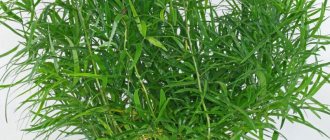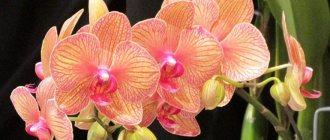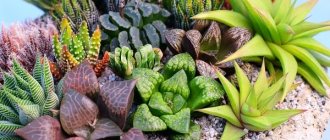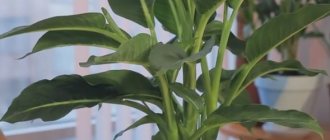Codiaēum is a beautiful plant. Its second name is croton. This is how it began to be called from the 18th century, when, due to similar characteristics, codiaum was assigned to this close genus. Now for a domestic flower, both names are synonymous and imply the same botanical species: variegated codiaum.
The genus Codium itself has only 17 species and belongs to the Euphorbiaceae family: the flower has a poisonous milky sap that can cause skin irritation, and if ingested, vomiting and diarrhea.
Codium croton is a poisonous plant. You need to work with it wearing gloves and with your hands covered. Its juice can cause skin irritation. You should also keep children and pets away from the pot with the flower.
This plant is valued for its decorative crown. It is used to decorate the interior; it looks good both at home and in the office. Its flowers are completely inconspicuous: the plant produces two arrows with male and female small flowers. Since the inflorescences are somewhat lost against the background of the leaves, and flowering takes a lot of energy, the arrows are cut off.
Trimming
In any magazine you can see beautiful photos of a croton flower. How to care for a plant to get the same beautiful tree? The crop requires pruning. By the way, many gardeners neglect it, although pruning is a mandatory part of care. Codium/croton (photo of the flower is given in the article) can have a very beautiful shape if it is formed regularly. Housewives refuse to form a crown due to the poisonous sap of the plant. But this is fundamentally wrong. The fact is that pruning has several functions:
- Formation of a beautiful tree or bush.
- Preventing possible depletion of the plant due to lack of nutrients to all shoots.
- Hygienic procedure for removing damaged and dry leaves and branches.
Don’t be scared by the plant’s poisonous sap, which won’t interfere with pruning at all. After all, in the end you want to get a beautiful indoor flower. How to care for Croton? When pruning the plant, you must wear gloves that will protect your skin. The juice helps the cuttings to tighten quickly, so the cuttings take root well.
The pruning procedure must be carried out regularly. After reaching the required height, all stems should be pinned or trimmed. This will activate the growth of dense lateral shoots.
It is worth saying that care also depends on the age of the plant. Indoor croton flowers are pinched if we are talking about a young bush. On adult specimens, the branches are cut off. After each such procedure, the plant must be treated with stimulants and placed in a greenhouse.
Please note that when pruning, it is necessary to remove flower buds and inflorescences, if any. Modest flowers do not decorate the bushes at all, but they greatly deplete them, which affects the decorative effect
Pruning plants of different varieties has its own characteristics. As you know, Croton "Petra" does not branch very well. If you want to achieve the splendor of the bush, it is worth planting several bushes in one flowerpot. You can create a wonderful mix. In this case, it is necessary to form each plant separately.
Pruning of the crop should be done in early spring. It is better to do this before the onset of the active growing season. The first pinching can be done when the plant reaches 15 cm in height. In this case, the upper growth points are cut off. In the future, all shoots are cut when their length reaches 20 cm. This cutting scheme allows you to awaken the lateral buds in order to force the bush to actively branch.
Forming a beautiful bush is not only about proper pruning. The plant must be regularly rotated relative to the light source. This will avoid one-sided crown. For adult crotons, the cutting area must be treated with crushed charcoal. By the way, cut cuttings can be used to produce new plants.
Is the plant poisonous?
Croton is poisonous. When its juice enters the stomach, all the signs of food poisoning appear.
All work with codiaum should be carried out with gloves, and then wash your hands thoroughly with soap.
Croton is an amazingly beautiful, but capricious plant. With proper care and attention, it will decorate your home for many years with its unusual variegated foliage. To understand what a flower lacks, pay attention to its condition. You just have to be patient and you will definitely make friends with this handsome guy.
Croton in winter
The content of croton in winter is not much, but still differs from summer conditions. Watering is reduced a little, but they adhere to the rule that the earthen ball should always be moistened.
Wiping the leaves and spraying is carried out a little less often. But it’s better to avoid showering in winter.
Priming
For good development, codiaum needs loose, well-fertilized soil. A ready-made mixture for decorative foliage plants, which you can buy in a store, is perfect.
To make your own soil, mix in equal proportions:
- turf land;
- deciduous soil;
- peat;
- sand.
Heat the mixture in the oven for 30 minutes to kill fungi and other harmful microorganisms that may be present in the soil.
Pot
A young croton is transplanted annually into a shallow pot, slightly larger than the previous one. Mature specimens need to be replanted every 2-3 years when the roots begin to peek out of the drainage holes.
When choosing a new pot, give preference to a slightly larger one, the diameter of which is approximately 5 cm larger than the previous one.
Location
Heat-loving croton grows and develops well at temperatures of +18–25ºС. Temperatures that fall outside this range - above +26ºС and below +18ºС have a detrimental effect on the plant.
With prolonged cold temperatures below +14ºС, croton can get sick, shed all its leaves and die.
The plant does not tolerate drafts, so it is not recommended to place it near an open window or even take it out onto the balcony in summer.
Eastern or western windows are most suitable for placing croton. In the summer heat, shade the plant a little so that the scorching rays of the sun do not burn the leaves.
In winter, it is advisable to move the plant to the sunniest windowsill.
Features of cultivation
It takes a long time for a plant to get used to new conditions when purchased or transplanted. For croton to feel good, it is necessary to maintain a comfortable temperature and humidity for it.
In order for the codiaum to retain the pattern and brightness inherent in the variety, it is necessary to provide it with long daylight hours and bright lighting. However, it is worth remembering that the scorching rays of the sun can cause burns to the leaves. Therefore, when placing a plant on southern windows, you should think about shading so that the light is bright but diffused.
Croton propagation
Growing from seeds
At home, croton is propagated by seeds, when it comes to growing hybrids, and by stem or leaf cuttings. Croton seeds quickly lose their viability, so you need to sow freshly harvested seeds. It should also be taken into account that the germination process takes a lot of time, and most importantly, that varietal characteristics are usually not preserved during generative propagation. Before planting, large croton seeds should be heated for half an hour in water at a temperature of 60 ºC and left for a day to swell. Sowing is carried out at a depth of one centimeter, the temperature required for seed germination is 22 ºC. Until the seedlings appear, the soil in the container with the seeds is moistened with bottom watering. When the seedlings have their third leaf, they are planted in separate pots with a diameter of 7 cm and cared for like an adult croton.
In the photo: Growing crotonVegetative method of propagation
How to propagate croton by cuttings? The easiest way to root is an apical cutting 6-10 cm long, but if you need several cuttings, then the shoot is cut into pieces so that each segment has at least one internode with one healthy leaf. Lignified or semi-lignified cuttings take root most easily.
The poisonous milky sap that flows from the sections should be washed off with water, and then the sections should be allowed to air dry for three hours.
On the upper part of the apical cutting, the leaves are shortened parallel to the veins by half, and the leaves are removed from the lower part. Then the cuttings are placed, dried and root-treated, into a container with water heated to 23-30 ºC (to avoid rotting of the planting material), and placed under bright, diffused light to grow roots. When the cutting grows roots 2 cm long, it is transplanted into a croton substrate. In the first decade after transplantation, it is necessary to create increased air humidity around the cuttings transplanted into the ground through frequent spraying. You will know that the cuttings have begun to grow when the elasticity of the leaf is restored.
Possible difficulties
— Due to a lack or excess of light, the leaves lose color.
— Due to direct sunlight, burns appear on the leaves.
— Due to dry air or soil, the tips of the leaves turn brown; if the temperature is too low, the edges of the leaves become brown. For the same reasons, the lower leaves fall off.
— Brown tips of leaves indicate a lack of moisture in the substrate and in the air, and if the edges of the leaf blade are also colored this color, it is necessary to increase the ambient temperature.
— Large leaves easily absorb dust, and they are wiped with a soft, damp sponge at least 2-3 times a decade.
— With low air humidity, codiaum is easily attacked by pests and diseases.
— At a temperature of 12°C, dulling of the surface of the leaves is observed, and with a long stay at 10-12°C, the leaves crumble.
Young leaves are less brightly colored than older leaves. This is normal for the plant.
I'm a fan of variegated plants. I once had a gorgeous codiaum with large leaves in my collection, but it did not survive intensive ventilation. Recently, I began to restore a collection of decorative foliage “pets”. At the top of my wish list is codiaum; I can’t afford to buy a plant now, because... large specimens are sold, and it’s not interesting for a gardener; you want to grow it yourself.
Propagation of branched crotons with narrow leaves (for example, Golden Finger) is not difficult; they can be propagated from cuttings. The situation is more difficult with broad-lobed crotons (such as Bravo or Holuffiana), they only have a stem and large patterned leaves. I read on a gardening forum that there are legends that such a specimen can be grown from a leaf. I asked my friends for a leaf, cut it off with a very small heel, because... alien plant.
I buried the leaf in the ground, made supports for it so it wouldn’t fall over, and built a greenhouse over it. Then I relied on my “light hand.” Usually everything I plant takes root.
The leaf sat unchanged for a very long time, then began to lose color a little.
I took it out, the petiole was not rotten, but there were no signs of roots. I dipped it in a mixture of root and activated carbon. The leaf very quickly turned yellow and became limp.
Question for gardeners: is it possible to propagate codiaum from leaves? If not, how to get a young plant of broadleaf varieties?
Transplanting croton after purchase into open ground
After purchasing codiaum, it is recommended to transplant the plant into another soil, because the substrate used when transporting seedlings is not always suitable for long-term cultivation.
However, the croton flower should not be replanted on the same day it was purchased. Planting can begin after at least 10 days. During this time, the plant acclimatizes and will tolerate replanting more easily.
For young bushes, it is recommended to replant every year, for adults - no more than once every three years (as the root system grows).
It is best to replant a bush in spring or early summer.
What you need to plant croton
For optimal growth and development, codiaums need light and fertile soil. To prepare the substrate yourself, take turf soil, fine sand, humus and peat in equal proportions. All components of the substrate are thoroughly mixed.
Additionally, you can add a little charcoal or ash to the soil. This will prevent the spread of putrefactive diseases in plants.
For planting, you can purchase universal soil for indoor plants at a specialty store. Also, for replanting, it is necessary to prepare a flower pot with a diameter of 3 cm larger than the previous one, made of plastic or clay
An important condition is that it must have large drainage holes.
Choosing the optimal location
A warm, sunny place without drafts is best suited for growing codiaum. With insufficient lighting, the leaves will lose their variegated color and become monochromatic.
Direct sunlight will not harm the leaves, but it is preferable for the light to be diffused. It is best to place the flower on a window that faces west or east.
In order for the codiaum to feel comfortable and develop normally, the surrounding air must be moist. The flower should not be placed next to heating appliances that dry out the air too much.
Step by step planting process
- First of all, you need to prepare a flower pot.
- Sterilized drainage is poured onto the bottom. This can be crumbs of broken red brick, expanded clay, polystyrene foam, etc.
- Part of the soil mixture is poured onto the drainage, lightly compacted and moistened.
- The plant is taken out of the pot. Be sure to monitor the integrity of the earthen coma. It must not be destroyed. It is better to use the method of transferring from one pot to another.
Croton transplant
- Inspect the root system. If rotten roots are noticed, they need to be removed.
- Place the flower in the pot and fill the pot with the remaining mixture. In this case, you need to ensure that there are no voids left between the earthen lump and the walls of the pot. The container can be shaken periodically so that the soil evenly fills the free cavities.
- After transplanting, the soil is watered moderately, the leaves are sprayed with water and the pot is placed in a warm, shaded place.
If you do not want to grow a tall croton flower, then there is no need to replant. If the ground is covered with a white coating, then you can simply update it a little. To do this, carefully remove the top layer of soil (3-5 cm) and pour new soil on top.
Croton care at home
Lighting
The croton plant at home needs bright but diffused lighting. On northern windows, additional lighting with fluorescent lamps may be required, and on southern windows, crotons will need to be placed away from the window so that the plant does not get burned. Homemade croton grows best on western or eastern windowsills. Insufficient lighting leads to fading of the pattern on the leaves, so variegated species need longer daylight hours.
Temperature
Indoor croton needs a stable temperature, both soil and air. In winter, the temperature should not fall below 18 °C, so the pot should be placed close to heating devices, but at the same time it is necessary to maintain high air humidity. Drafts must be avoided. In summer the temperature should be around 22 °C.
Watering Croton
Throughout the year, the soil is not allowed to dry out - you need to water the indoor croton flower immediately after the top layer of soil in the pot has dried. Water for irrigation is taken soft and warm, and before that it is allowed to settle for 24 hours so that as much lime as possible can settle.
Spraying
Croton indoors needs to be sprayed daily, since high air humidity is one of the main conditions for its cultivation. If spraying is not enough, you can place a container of water next to the croton pot. You can wipe the leaves with a damp cloth from time to time. The water must stand for at least 24 hours.
Top dressing
In winter, homemade croton is fed once a month with mineral and organic fertilizers diluted in half. The rest of the time they feed weekly and also alternately.
Trimming
The indoor croton plant must be pinched to make the crown voluminous and beautiful. The first time is pinched on the outer bud when the plant grows to 15 cm. Then every 20 cm.
Croton transplant
It is better to take a small pot. We pour drainage at the bottom, and make up the substrate from humus, peat, sand, turf and leaf soil in equal parts. You can add charcoal. Crotons must be replanted annually if the plant is young. Older plants are replanted after 2-3 years. Crotons do not need to be replanted, but rather transshipped.
Propagation by cuttings
Cuttings are suitable for both apical and woody stem parts. Before planting croton cuttings, it is necessary to allow the milky juice to drain at the cut site, and the cut itself must be made with a sharp knife or blade. The cuttings are washed in warm water, treated with a root formation stimulator and powdered with charcoal powder. The cuttings are planted one at a time in small pots with a mixture of peat and sand. The temperature should be 24-26 °C, the cuttings are regularly sprayed and the soil is moistened. Within 30-40 days, crotons take root, after which they are planted in a substrate of equal parts of sand, peat, humus, leaf and turf soil. You need to add drainage to the bottom of the pot.
Virulence
Homemade croton contains poisonous juice, contact with the skin can cause severe irritation, and ingestion can cause diarrhea and vomiting. After working with a flower, you need to wash your hands with soap. Make sure children do not chew the leaves or rub their eyes after planting.
Description
The color of the foliage is incredibly varied: yellow, red, orange, purple, black dots and stripes are combined with lacy silver and bronze patterns.
Such magnificence, apparently, became the reason to call this plant “Joseph’s cloak” - after the name of the biblical character who received from his father, to the envy of his brothers, brightly colored clothes of fine workmanship.
They are called variegated codiaum and croton. This name is considered inaccurate by botanists.
Like many members of the Euphorbia family, the sap that contains Joseph's Cloak Croton is poisonous.
Therefore, it is not recommended to grow the plant where there are small children and pets, and after working with it you should wash your hands well.
When grown indoors, codiaum does not grow above a meter. He is demanding of living conditions, which should resemble his favorite jungle: warm, with bright lighting and high humidity.
However, at home, codiaum, “dressed in crimson and gold,” can not only be grown, but also propagated.
Codiaum propagation
Croton propagation at home is most often carried out during the formation of the crown - molding. In this case, the cut off tops remain (this is necessary for the plant to grow side shoots and grow in width). These tops are rooted in soft warm water and wait for the roots to grow.
A less rational method is seed. This requires several flowering plants, since the flowers of codiaum are dioecious. For pollination to occur, a male and female plant must flower at the same time.
If you need to get several plants at once, you can germinate the leaves by separating them from the shoot and placing them in containers with liquid.
Seeds
Seeds are most often purchased. There is a risk here that you will get stale specimens that will not germinate. They must be fresh. Step-by-step procedure on how to germinate croton and how to care for it at home after germination:
Disinfect seed material with a solution of potassium permanganate.
Leave in clean water for the shell to swell and soften for a day.
Prepare soil consisting half of high-moor peat and sand.
Place the seeds to a depth of 1 cm and cover with a loose layer of soil.
Cover with film to prevent moisture from evaporating.
Place in diffused light.
It is necessary to ventilate the greenhouse periodically to prevent condensation from forming inside. This can lead to seed rotting. Transfer to separate containers after the plant has produced 2 true leaves.
Cuttings
When cutting cuttings, you need to wear gloves so that the plant juice does not get on your hands, otherwise red spots and itching may appear. When cutting, juice is released, which is immediately washed off, and the sections are treated with a rooting agent or crushed charcoal. The tops should air dry for several hours. Further:
Prepare soil from peat and sand in equal proportions.
Spread the soil over the pots if the tops are large. Can be rooted in a common container, then planted.
The lower leaves are cut off, leaving two pairs at the top.
Deepen into the sand-peat mixture and compact.
While rooting occurs, and this process lasts 1 - 1.5 months, the plants are kept at a temperature of 24 degrees, maintaining humidity at 50 - 55%. When young leaves appear at the top and the roots grow to 2 cm, you can transplant them into a separate pot. It should be 2 cm larger than the diameter of the roots, otherwise the soil will acidify and the plant will rot.
Leaves
By separating the leaf you can get a new flower. Propagation of croton by leaves also brings good results:
You need to cut off the leaf with the petiole.
Treat its edge with heteroauxin or another rooting agent.
Let it sit in the air for a couple of hours.
Prepare warm water, preferably rainwater.
Place the edge of the petiole in the liquid.
You need to make sure that the leaf does not fall completely into the water - only the edge where the roots will form should be in it. Place the container in diffused light. In a month, roots will appear. They can be planted in the soil when their length is at least 2 cm.
By layering
Codium/croton propagation by layering is carried out in two ways. The first involves growing the root system on an adult plant - at a distance of about 15 cm from the top. For the second option, you need to have several woody shoots that can be dug into the soil and wait for the roots to sprout.
How to propagate by layering:
On the woody part of the trunk, remove the bark in a circle with a sharp knife.
Lubricate the bare area with any rooting agent so that roots form faster.
Wrap the area with sphagnum moss and tape the film on top. Strengthen the bottom edge tightly. From above so that you can spray the moss.
Within a month, roots appear. Depending on how many leaves are located above the formed layer, it is grown to 4–5 cm. Next, the layer is cut off below the root bunch and transplanted into a pot with prepared soil.
In the second method, one of the shoots is exposed, placed in the ground and sprinkled. You can periodically water it with rooting agent. When sprouts appear from the ground, they are cut, separated from the mother plant and replanted.
Croton varieties and names
There are only 15 species of codiaum in the wild. Thanks to the work of breeders at home, we can grow its new bright varieties.
Codiaum variety Mammi
A bright plant with unusually shaped leaves. Narrow wavy leaves, even on the same plant, can have different colors: red, green with yellow or pink splashes.
Codeium Excellent
An elegant bush whose leaves resemble oak. The leaf blades contain many colored veins of golden yellow and red. The brightness of the leaves depends on their age; the older the leaf, the more red shades it contains. Young foliage has a green-yellow hue.
Croton Mrs. Eyeston
Large-leaved codiaum with oblong-shaped leaves, pointed at the ends. Young leaves also have a green color with yellow veins, but over time they acquire pink, red, orange shades, some of them become dark green, almost black. The veins on the leaves are dark in color.
Codium Mix
In stores you can find plants called “Codiaeum Mix”. This suggests that the batch includes several varieties. The main feature is that their upper leaves have a clear edge of the same color as the leaf veins. The leaves are about 20 cm long.
Croton Sunny Star
One of the most beautiful sunny varieties of croton. The bright yellow color sometimes occupies almost the entire part of the thin tongue-shaped leaf. Numerous shoots with graceful leaves are especially decorative.
Codiaum aucubifolia
Bright yellow spots seem to be splashed on the dark green leaves of this plant. The leaf blades are narrow and have an oval-pointed shape. The variety is especially loved by flower growers.
Motley
Able to change the shape and color of foliage, depending on external factors. Due to this, it is used to obtain new varieties and hybrids that are very different in appearance.
Narrow-leaved
This group is distinguished by long, up to 30 cm and thin, about 1 cm leaves.
Splashes of champagne
The long narrow leaves of this variety are colored rich green. The brightness of the plant is added by numerous yellow spots of various diameters and shapes, which are located along the entire length of the leaf.
Zanzibar
It looks very exotic in the interior. Its long, narrow leaves have shades of green, yellow and red. All these colors collected in one Zanzibar bush make it especially bright and unusual.
Petra
The most famous and best-selling variety of croton. Large, sinewy, ovoid leaves reach 30 cm in length and form a compact decorative crown. The main feature of Petra is the very thick veins that run from the center of the leaf blade. Green and yellow colors predominate. Only older leaves take on a red tint.
Subspecies
A huge number of hybrid forms are known in culture. Some varieties and forms:
Codiaeum variegatum var. genuinum diff. Genuine - the leaves are flat, entire, lanceolate or elliptic-lanceolate, the apex and base are pointed. On the upper side of the leaf, especially along the central vein, golden or silver painting is noticeable. Sometimes the leaf has a reddish tint.
Codiaeum variegatum var. ovalifolium diff. oval-leaved - the leaves are oblong-oval, flat, entire, rounded-blunt at the tops and at the base, with pronounced golden-yellow areas on top and along the veins.
Codiaeum variegatum var. picturatum diff. decorated - resembles the previous one in leaf shape, but the “second” leaf is narrower and elongated, rather elongated-lanceolate.
Codiaeum variegatum var. recurvifolium diff. turned-leaved - has wide, almost oval leaves, their edges are turned outward.
Codiaeum variegatum var. tortile diff. tortoiseshell - the leaf blade is deltoid or heart-shaped at the base, elongated at the top, linear with a slightly pointed apex, leaf spiralization is weakly expressed. The leaves of various forms of this variation are distinguished by their variegated color: against an olive-green background, a reddish central vein, along which there is a golden stripe, and irregularly shaped spots of the same color scattered on both sides of the central vein stand out clearly. One plant may have leaves that are completely golden or have a reddish tint.
Codiaeum variegatum var. trilobium diff. trilobed - the base is wedge-shaped or deltoid, the leaf blade is tripartite. The color of the leaf is varied: there are forms with golden central and lateral veins, which are emphasized by spots of the same color. Other plants have wide golden stripes along the central and lateral veins.
Codiaeum variegatum var. volutum diff. wrapped - the broadly lanceolate, elongated leaves are rolled inward towards the stem, as a result of which the plant takes on an almost spherical shape.
Codiaeum variegatum f. angustifolium form narrow-leaved - leaves are narrow, linear, 15–20 cm long, 0.5–1.0 cm wide, apex slightly elongated. Golden spots are scattered randomly on a green background; the veins can also be painted the same color.
Codiaeum variegatum f. appendiculatum Celak
appendage-like shape - attracts attention with the original shape of the leaves. The broadly ovate or lanceolate-ovate leaf blade narrows at the apex, forming, as it were, a second petiole, on which a second leaf blade is formed, resembling the main one in shape, but smaller in size.
The color on both sides is green, although there are also variegated forms.
Codiaeum variegatum f. crispum cv. Spirale form curly cultivar Spirale - leaves petiolate, prostrate, rather long and narrow, oblong or linear-lanceolate, twisted into a spiral. Within this variety there are plants with different shapes of the leaf blade: linear-lanceolate leaves with golden veins forming a reticular pattern on a green background; leaves of the same shape, but spiral-curled with a golden central vein; leaves are lanceolate, extending from the stem at an angle of 30–45 °, rounded, along the central vein there is a golden stripe of indeterminate shape; the leaves are longitudinally lanceolate, more or less spirally twisted, with golden spots diffusely scattered across the green background.
Codiaeum variegatum f. lobatum has a lobed shape - the leaves are simple, quite large (18–22 cm long, 7–10 cm wide), the leaf blade is three-lobed, the central lobe is elongated, the lateral ones are shorter, separated from it by a deep notch. The base of the leaf is narrowed. The leaves are green with yellow stripes and spots.
Organization of watering
There are a few simple care rules that will help keep the plant healthy for a long time. How to water a flower correctly:
- Croton loves high air humidity, and therefore the leaves must be periodically wiped with a damp cloth. Regular spraying of the bush with a spray bottle will help ensure the proper level of humidity.
- In summer, an additional summer shower will be required.
- Watering is carried out on demand, as the soil in the pot partially dries. Do not allow water to stagnate in the flower tub, which can cause root rot.
3.Types of croton:
3.1.Croton Tamara Branch
Bright ornamental bushes up to 1.5 m high with erect, weakly branching stems, densely leafy oblong, lanceolate, hard leaves with large white and green spots.
3.2.Croton Excelent
Spectacular variegated plants with oblong, three-lobed leaves, colored emerald green. A distinctive feature of the variety is the presence of yellow, pinkish or red stripes on the leaf blades, located mainly along the leaf veins.
3.3.Mrs. Iceton's Codeium
Variegated plants with strong, erect, unbranched stems bearing bright, variegated leaves of a wide variety of shades. The leaf blades are glossy, hard, lanceolate. Unlike other crotons, this variety retains foliage along the entire length of the trunk and does not expose its lower part.
3.4.Croton Mammi – Codiaeum mammi
Beautiful plants with oblong, brightly colored leaves. The shades of the leaves are predominantly dark in color. The edges of the leaf blades have graceful curves, making the plant appear lush and curly.
3.5.Croton Zanzibar
Long-leaved codiaum with long, gracefully drooping leaf blades, dark green in color with longitudinal yellow, burgundy, purple or pink stripes and small contrasting specks on the surface.
3.6.Croton aucubifolia
Spotted plants with oblong, lanceolate leaf blades, which sometimes take on a vague three-lobed shape in mature plants. The leaves are glossy and green with small yellow spots on the surface.
3.7.Croton Nervia
Weakly branched, erect bushes with lanceolate, entire green leaves. Along the veins, the leaf blades have light yellow, wide stripes diverging from the center. The central vein is often highlighted in pink.
3.8.Croton Tiglium or laxative
This variety does not have a bright, beautiful appearance, but it has healing properties and, as the name suggests, is used as a laxative. The plant is an evergreen tree with lanceolate, green, glossy leaves. The lower surface of the leaf plates is painted in a lighter shade. During the flowering period, plants form small oblong inflorescences with inconspicuous flowers, which over time turn into rounded fruits. When ripe, the fruits acquire a yellowish-orange hue.
3.9. Croton curly
The main distinguishing feature of curly croton is its leaf blades with beautiful, curved edges. Leaf shades include green, yellow, pink, red, burgundy.
The leaves of three-lobed codiaums have two rounded projections on the sides - lobes.
Motherland
The Croton plant is native to Southeast Asia , Oceania, India and Malaysia, and is also found in Central America. In the forests of its homeland, it grows in the form of a tree with an erect trunk and reaches a height of two meters , preferring to remain in the partial shade of taller trees, or has a shrubby form , occupying the lower layer of the rainforest.
There are also low, and even very low, herbaceous forms.
However, if the vegetation density is too high and there is not enough sunlight, the plant loses its brightness and turns green.
Croton is used in folk medicine : croton oil, which has laxative properties, is obtained from its seeds, and a spicy-aromatic mixture is prepared from the bark. In this case, special technologies are used, given that all parts of the plant are poisonous.











